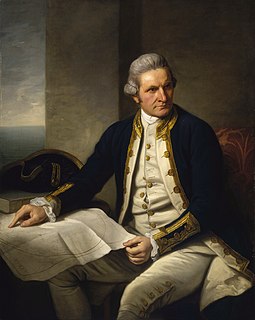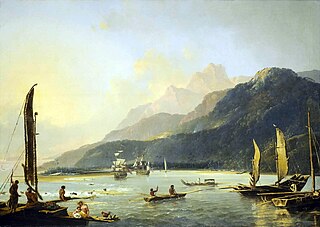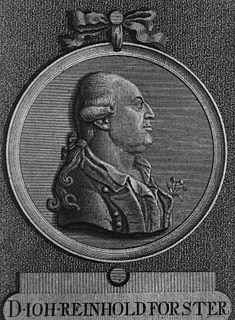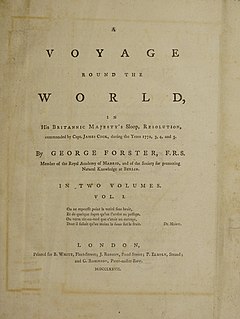
Captain James Cook was a British explorer, navigator, cartographer, and captain in the British Royal Navy, famous for his three voyages between 1768 and 1779 in the Pacific Ocean and to Australia in particular. He made detailed maps of Newfoundland prior to making three voyages to the Pacific, during which he achieved the first recorded European contact with the eastern coastline of Australia and the Hawaiian Islands, and the first recorded circumnavigation of New Zealand.

Johann George Adam Forster, also known as Georg Forster was a German naturalist, ethnologist, travel writer, journalist and revolutionary. At an early age, he accompanied his father, Johann Reinhold Forster, on several scientific expeditions, including James Cook's second voyage to the Pacific. His report of that journey, A Voyage Round the World, contributed significantly to the ethnology of the people of Polynesia and remains a respected work. As a result of the report, Forster, who was admitted to the Royal Society at the early age of twenty-two, came to be considered one of the founders of modern scientific travel literature.
John Cawte Beaglehole was a New Zealand historian whose greatest scholastic achievement was the editing of James Cook's three journals of exploration, together with the writing of an acclaimed biography of Cook, published posthumously. He had a lifelong association with Victoria University College, which became Victoria University of Wellington, and after his death it named the archival collections after him.

HMS Endeavour was a British Royal Navy research vessel that Lieutenant James Cook commanded to Australia and New Zealand on his first voyage of discovery from 1768 to 1771.

HMS Resolution was a sloop of the Royal Navy, a converted merchant collier purchased by the Navy and adapted, in which Captain James Cook made his second and third voyages of exploration in the Pacific. She impressed him enough that he called her "the ship of my choice", and "the fittest for service of any I have seen".

Johann Reinhold Forster was a Reformed (Calvinist) pastor and naturalist of partially Scottish descent who made contributions to the early ornithology of Europe and North America. He is best known as the naturalist on James Cook's second Pacific voyage, where he was accompanied by his son Georg Forster. These expeditions promoted the career of Johann Reinhold Forster and the findings became the bedrock of colonial professionalism and helped set the stage for the future development of anthropology and ethnology. They also laid the framework for general concern about the impact that alteration of the physical environment for European economic expansion would have on exotic societies.
The year 1776 in science and technology involved some significant events.

Ripogonum is a genus of flowering plants confined to eastern Australia, New Zealand, and New Guinea. Until recently this genus was included in the family Smilacaceae, and earlier in the family Liliaceae, but it has now been separated as its own family Ripogonaceae.

The Tanna ground dove, also known as Forster's dove of Tanna, is an extinct dove species. Its taxonomic affiliation is uncertain but at its first scientific discussion by Johann Georg Wagler in 1829 it was classified into the genus Gallicolumba ; its closest relative is possibly the Santa Cruz ground dove. It was endemic to the Pacific island of Tanna, Vanuatu. Forster records a native name mahk, almost certainly from the Kwamera language.

Warrington Academy, active as a teaching establishment from 1756 to 1782, was a prominent dissenting academy, that is, a school or college set up by those who dissented from the established Church of England. It was located in Warrington, a town about half-way between the rapidly industrialising Manchester and the burgeoning Atlantic port of Liverpool. Formally dissolved in 1786, the funds then remaining were applied to the founding of Manchester New College in Manchester, which was effectively the Warrington Academy's successor, and in time this led to the formation of Harris Manchester College, Oxford.

The first voyage of James Cook was a combined Royal Navy and Royal Society expedition to the south Pacific Ocean aboard HMS Endeavour, from 1768 to 1771. It was the first of three Pacific voyages of which James Cook was the commander. The aims of this first expedition were to observe the 1769 transit of Venus across the Sun, and to seek evidence of the postulated Terra Australis Incognita or "undiscovered southern land".

Stenocarpus umbelliferus is a species of flowering plant in the family Proteaceae. It is endemic to New Caledonia. It has a prostrate or upright habit, growing up to 5 metres in height. Stems are flattened when young, later becoming rounded. The leaves are thick and leathery with a slightly wavy margin. These may be ovate, elliptic, lanceolate or spathulate in shape with petioles that are 3 to 12 mm long. White, cream or pale yellow flowers occur in groups of 3 to 8 per umbel. These are followed by dark-coloured glabrous follicles that are 25 to 80 mm long and 3 to 5 mm wide.

The second voyage of James Cook, from 1772 to 1775, commissioned by the British government with advice from the Royal Society, was designed to circumnavigate the globe as far south as possible to finally determine whether there was any great southern landmass, or Terra Australis. On his first voyage, Cook had demonstrated by circumnavigating New Zealand that it was not attached to a larger landmass to the south, and he charted almost the entire eastern coastline of Australia, yet Terra Australis was believed to lie further south. Alexander Dalrymple and others of the Royal Society still believed that this massive southern continent should exist. After a delay brought about by the botanist Joseph Banks' unreasonable demands, the ships Resolution and Adventure were fitted for the voyage and set sail for the Antarctic in July 1772.

James Cook's third and final voyage took the route from Plymouth via Cape Town and Tenerife to New Zealand and the Hawaiian Islands, and along the North American coast to the Bering Strait.

The Tahitian Dog is an extinct breed of dog from Tahiti and the Society Islands. Similar to other strains of Polynesian dogs, it was introduced to the Society Islands and Tahiti by the ancestors of the Tahitian (Mā’ohi) people during their migrations to Polynesia. They were an essential part of traditional Tahitian society; their meat was included in Tahitian cuisine and other parts of the dog were used to make tools and ornamental clothing. Dogs were fed a vegetarian diet and served during feasts as a delicacy. European explorers were the first outsiders to observe and record their existence, and they were served to early explorers including Captain James Cook. The Tahitian Dog disappeared as a distinct breed after the introduction of foreign European dogs.

A Voyage Round the World is Georg Forster's report on the second voyage of the British explorer James Cook. During the preparations for Cook's voyage, the expedition's naturalist Joseph Banks had withdrawn his participation, and Georg's father, Johann Reinhold Forster, had taken his place at very short notice, with his seventeen-year-old son as his assistant. They sailed on HMS Resolution with Cook, accompanied by HMS Adventure under Tobias Furneaux. On the voyage, they circumnavigated the world, crossed the Antarctic Circle and sailed as far south as 71° 10', discovered several Pacific islands, encountered diverse cultures and described many species of plants and animals.
Charles Irving was a Scottish naval surgeon and inventor. In 1770, he introduced a method for distillation of seawater to the Royal Navy, and was awarded the sum of £5,000 for his method in 1772. His apparatus for distilling seawater was used on the second voyage of James Cook and on the 1773 expedition by Constantine John Phipps towards the North Pole, in which Irving participated both as surgeon and as scientific collaborator of Phipps. He was later involved in British colonial enterprises in Central America that included an attempt to establish a crown colony on the Mosquito Shore, but his plans were thwarted by Spanish intervention.

Marie Therese Forster was a German educator, writer, correspondent and editor. Born in Vilnius in the Polish–Lithuanian Commonwealth to Georg Forster and his wife Therese, she spent her early childhood in Mainz. Her father was active in the revolutionary Republic of Mainz, and she and her mother fled the city in late 1792. After her father's death, she was raised by her mother and stepfather Ludwig Ferdinand Huber. From 1801 to 1805, Forster lived with Dutch-Swiss writer Isabelle de Charrière and collaborated with her on an epistolary novel. Until 1826, she worked as a teacher and educator, first at Philipp Emanuel von Fellenberg's school in Hofwil and then for several upper-class families. After her mother's 1829 death, she lived with family and educated her nieces and nephews. From 1840, she collaborated with Georg Gottfried Gervinus on the first complete edition of her father's works, which were published by Brockhaus in 1843. Therese Forster spent her later years with her niece and died in Albisheim aged 75.

Characteres generum plantarum is a 1775/1776 book by Johann Reinhold Forster and Georg Forster about the botanical discoveries they made during the second voyage of James Cook. The book, which contains 78 plates, introduced 94 binomial names from 75 genera, of which 43 are still the accepted names today.


















